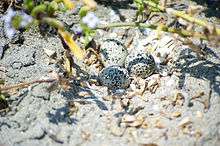Snowy plover
The snowy plover (Charadrius nivosus) is a small wader in the plover bird family. It breeds in Ecuador, Peru, Chile, the southern and western United States and the Caribbean. Long considered to be a subspecies of the Kentish plover, it is now known to be a distinct species.
| Snowy plover | |
|---|---|
 | |
| Snowy plover near Cayucos, California | |
| Scientific classification | |
| Kingdom: | Animalia |
| Phylum: | Chordata |
| Class: | Aves |
| Order: | Charadriiformes |
| Family: | Charadriidae |
| Genus: | Charadrius |
| Species: | C. nivosus |
| Binomial name | |
| Charadrius nivosus Cassin, 1858 | |
Taxonomy
Genetic research published in 2009 strongly suggested that the snowy plover is a separate species from the Kentish plover,[2] and by July, 2011, the International Ornithological Congress (IOC), and the American Ornithologists' Union (AOU) North American committee have recognized them as separate species. Other taxonomic committees are reviewing the relationship.
Physically, snowy plovers are shorter-legged, paler and greyer above than their Old World sister species, and breeding males lack a rufous cap. The eye mask is also poorly developed or absent.
Reproduction, Range, and Movement

The snowy plover breeds on sandy coasts and brackish inland lakes, and is uncommon on fresh water. It nests in a ground scrape and lays three to five eggs.[3]
.jpg)
Breeding birds in warmer countries are largely sedentary, but northern and inland populations are migratory, wintering south to the tropics.
In North America, the snowy plover breeds from Texas and Oklahoma west to California and up the coastline to Oregon and Washington. The coastal form's primary breeding concentration is in central and southern California.[4] On March 5, 1993 the western snowy plover was listed as a threatened species under the Endangered Species Act of 1973. As of June 19, 2012, the habitat along the California, Oregon, and Washington Coasts have been listed as critical.[5]
In many parts of the world, it has become difficult for this species to breed on beaches because of disturbance from the activities of humans or their animals. The University of California, Santa Barbara (UCSB) is currently endeavoring to rehabilitate snowy plover populations by protecting beaches along the central California coastline that runs along part of the university campus.[6] UCSB has had some success in encouraging reproduction; the university also often trains students and other volunteers to watch over protected beaches during the daytime to ensure no one disturbs nesting grounds. But even with the conservation efforts their population is slowly dwindling, it's estimated that only about 2,500 western snowy plovers breed along the Pacific Coast.[7]
The beaches lining Vandenberg Air Force Base in Central California are also home to several protected areas where breeding has been successful in recent years. Access to these beaches is limited to certain times of the year, and very specific areas are open to keep the bird protected. Most of these beaches are only open to military personnel and their families.
Diet
Coastal snowy plovers will hunt both close to the water's edge, as well as in drier, sandier areas. Inland birds favor damp, wetter environments. Food is typically obtained by a run-and-pause technique, though birds have been known to probe sand and chase insects near carcasses.[8] The species primarily feeds on invertebrates, such as crustaceans, worms, beetles, and especially flies.[9]
References
- BirdLife International (2012). "Charadrius nivosus". IUCN Red List of Threatened Species. 2012. Retrieved 12 August 2015.CS1 maint: ref=harv (link)
- Küpper, Clemens; Augustin, Jakob; Kosztolányi, András; Burke, Terry; Figuerola, Jordy; Székely, Tamás (2009). "Kentish versus Snowy Plover: phenotypic and genetic analyses of Charadrius alexandrinus reveal divergence of Eurasian and American subspecies". The Auk. The American Ornithologists’ Union. 126 (4): 839–852. doi:10.1525/auk.2009.08174.
- Sahagun, Louis (May 9, 2017). "Rare birds find Southern California beach housing". LA Times. Retrieved 26 August 2017.
- "Recovery Plan for the Pacific Coast Population of the Western Snowy Plover (Charadrius nivosus nivosus)" (PDF). U.S. Fish and Wildlife Service. Retrieved 12 February 2016.
- "Western Snowy Plover Species Profile". www.fws.gov. U.S. Fish and Wildlife Service. Retrieved 8 February 2016.
- "2003 UCSB Press Release on snowy plovers". World Heritage. Retrieved 21 May 2007.
- "Western Snowy Plover". Monterey Bay Aquarium. Retrieved March 6, 2020.
- Dunne, Pete (2006). Pete Dunne's Field Guide Companion. Houghton Mifflin.
- Bent, Arthur C. (1962). Life Histories of North American Shore Birds (Second ed.). Dover Publications, Inc.
Bibliography
- Gill, F.; Donsker, D., eds. (2011). "IOC World Bird List (v 2.9)". Retrieved 31 July 2011.
- Chesser, R. Terry; Banks, Richard C.; Barker, F. Keith; Cicero, Carla; Dunn, Jon L.; Kratter, Andrew W.; Lovette, Irby J.; Rasmussen, Pamela C.; Remsen, J. V.; Rising, James D.; Stotz, Douglas F.; Winker, Kevin (2011). "Fifty-second supplement to the American Ornithologists' Union Check-List of North American Birds" (PDF). Auk. 128 (3): 600–613.
- Kaufman, Kenn. “Snowy Plover.” Audubon, 15 Jan. 2020, www.audubon.org/field-guide/bird/snowy-plover.
External links
| Wikimedia Commons has media related to Charadrius nivosus. |
| Wikispecies has information related to Charadrius nivosus |
- Western Snowy Plover - Tools and Resources for Recovery
- "Charadrius nivosus". Integrated Taxonomic Information System.
- BirdLife species factsheet for Charadrius nivosus
- "Charadrius nivosus". Avibase.

- Snowy plover photo gallery at VIREO (Drexel University)
- Interactive range map of Charadrius nivosus at IUCN Red List maps
- Audio recordings of Snowy plover on Xeno-canto.
- Charadrius nivosus in the Flickr: Field Guide Birds of the World
- Snowy plover media from ARKive

